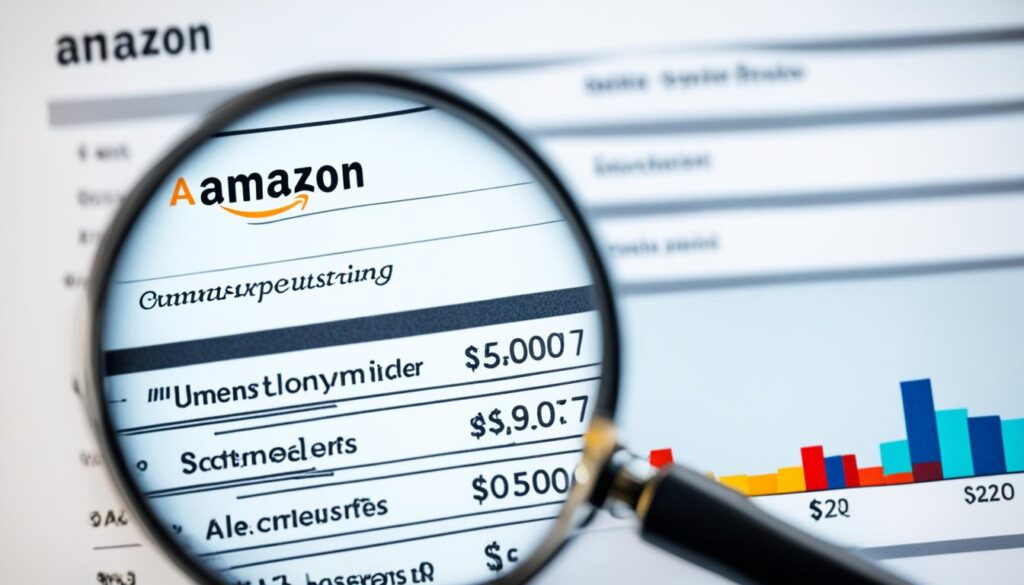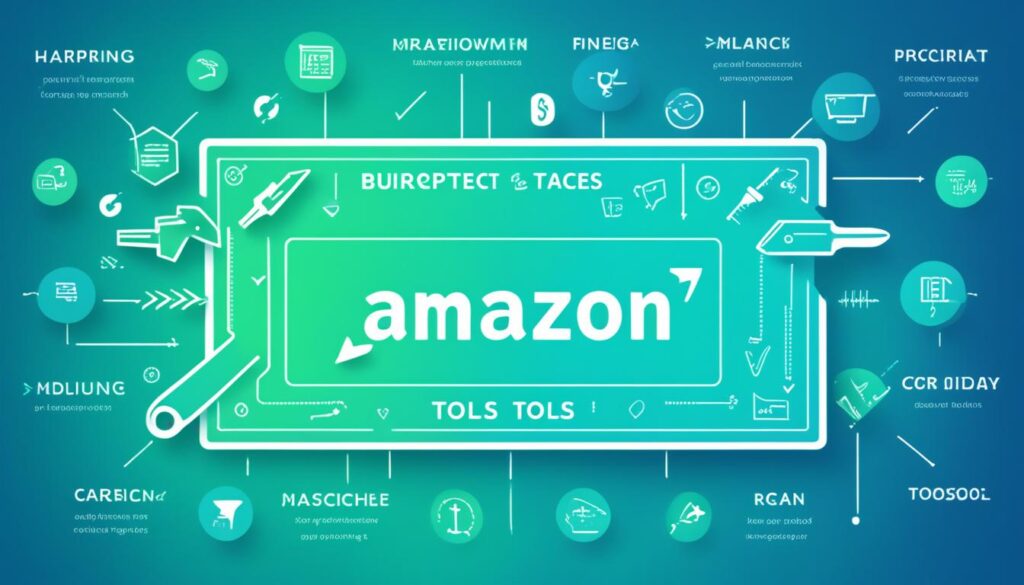Struggling to set the right price for your Amazon products? You’re not alone. With millions of sellers trying to grab customers’ attention, pricing is crucial. It can either make you a winner or lead to failure on this busy platform.
In the e-commerce world, your prices can sway customers’ decisions, impact your search rankings, and decide your profits. If your prices are too high, you may lose sales to cheaper competitors. But if they’re too low, you risk devaluing your niche and squeezing your own profits1.
Finding the perfect pricing balance on Amazon is key. Start by knowing your profit margins and checking out your competition. Use Amazon’s pricing tools smartly and embrace good pricing strategies. In 2023, 58% of Amazon sellers priced their products between $16 and $50. Meanwhile, 57% of the super successful ones offered products under $301. This shows how important it is to tweak your Amazon pricing strategy to turn in profits and do well on the site.
We’re going to explore competitive pricing on Amazon in depth in this article. You’ll get practical advice and strategies to keep you competitive. You’ll learn to calculate your profits, check out your rivals, make the most of Amazon’s tools, and use winning strategies to boost sales and expand your Amazon business.
Key Takeaways
- Understand your profit margins to ensure sustainable pricing
- Research competitors’ prices, shipping fees, and promotions to stay competitive
- Utilize Amazon’s Buy Box and automated repricing tools to optimize your prices
- Implement smart pricing strategies like A/B testing, charm pricing, and value-based pricing
- Regularly monitor sales, customer feedback, and market trends to adjust your pricing strategy
Understanding Your Profit Margins
If you want to sell well on Amazon, you must know your profit margins clearly. Your profit margin is the money you keep after paying all expenses. This includes the cost of goods, Amazon fees, PPC costs, and more2. It’s vital to keep your profit margin healthy to cover all your expenses. It will also help make sure your Amazon business stays profitable over time.
Calculating Your Profit Margin
Finding your profit margin is not too hard. You can use this simple formula: ((Your Sales Revenue – Total Expenses) ÷ Sales Revenue) x 1002. Or, try this formula: (Sales – Total Expenses/ Sales) * 100%3. Just put in your sales revenue and total expenses to see your profit margin percentage fast.
Aiming for a Healthy Profit Margin
Sellers on Amazon usually aim for a profit margin between 15% and 25%4. For items with a private label, the best profit margins are often between 25% and 30%2. Surprisingly, 58% of Amazon sellers make more than a 15% profit. And about half of them see margins from 21% to 50%4. A good profit margin gives you some flexibility with your ads at first. Those costs should drop as you get better at running your campaigns.
The “Rule of Three” says when you sell something for $30, about $10 goes to fees, $10 to costs, and $10 is profit. Keep in mind, this is with a 33% profit margin.
Factoring in Costs and Fees
When you decide on prices for Amazon, you must think about all costs involved. This covers the product’s cost, Amazon fees, shipping, storage, and ads2. Forgetting these costs can cut into your profits quickly. To stay competitive without lowering your prices too much, know the highest and lowest prices you can charge based on your costs and the profit you want.
| Profit Margin Range | Percentage of Amazon Sellers |
|---|---|
| Less than 10% | 21% |
| 11% to 20% | 37% |
| 21% to 50% | 38% |
| More than 50% | 4% |
To do well on Amazon, know your profit margins, calculate them accurately, and aim for a good range. Also, consider all costs and fees. This will prepare you to set prices that make your business successful.
Researching Your Competition
To set the right prices on Amazon, you need to research your competition deeply. Every day, almost 2,000 new sellers start on Amazon5. It’s key to know what your rivals are doing and the current market prices for success.

Analyzing Competitors’ Prices
Start by looking at what your top 10 to 20 competitors are charging, their shipping, and any promotions5. This shows you what price points are common in your category. Tools like Jungle Scout can help by showing average prices and suggesting your price6.
Look closely at your competitor’s titles, features, and product information to see where you can do better7. Also, take time to understand their branding for insights7.
Check out your rival’s reviews to see how well their products are rated overall7. Remember, reviews are big on Amazon, aiming to get better ones can help you stand out6.
Identifying Your Unique Value Proposition
If you’re selling your own brand, focus on offering high-quality products that are also affordable. Also, make sure your brand stands out from others in a unique way. It’s important to have something special that attracts your audience.
Study your competitor’s keywords to see what they’re focusing on and enhance your product descriptions with them7. Also, understand what they’re spending on ads and its effect to position yourself better7.
| Competitor Analysis Factor | Description |
|---|---|
| Pricing Strategies | Look at what others are charging and guess their monthly sales. This can help you be more competitive and profitable7. |
| Product Images and Videos | Quality images and videos on Amazon are key for your competitor’s product pages56. |
| Customer Reviews | Studying your competitor’s reviews can show what their products lack. This can help you stand out5. |
| Market Trends | By tracking trends through your competition, you can avoid markets that are going down or have low demand5. |
For products without reviews yet, consider starting with slightly lower prices than others for a short while. Just make sure not to go too low, as this can start a price war. Such a war could hurt your business in the long term.
Utilizing Amazon’s Pricing Tools
Amazon gives sellers many pricing tools for the ever-changing online market. Using these tools right can better your pricing plan and up your chances on Amazon.

Leveraging the Amazon Buy Box
The Buy Box is key for Amazon sellers. It makes your products more visible and boosts sales by pushing for the best prices8. Getting the Buy Box on Amazon needs more than just low prices. You also need fast shipping, good reviews, quality products, and clear descriptions8. Using different pricing tricks aims to win the Buy Box. You might drop prices, offer deals, or change shipping fees9.
Here are some tips for winning the Buy Box:
- Maintain competitive pricing
- Ensure excellent customer service
- Offer fast and reliable shipping
- Keep a healthy inventory level
- Maintain high product quality and ratings
Implementing Automated Repricing Strategies
Automatic repricing tools make changing prices easy. They update your prices following set rules8. On Amazon, using these tools can help you become the Featured Offer, which draws in more customers10. New prices take effect in less than 15 minutes after a rule update. Changes to the rules themselves might take up to an hour to take effect10.
When using automatic repricing, remember:
- Set minimum and maximum prices per item to keep profits up
- Think about what other sellers are pricing their items at, plus demand and supply
- Watch your price changes over time to spot trends and make adjustments
- Make sure your pricing rules match your overall pricing strategy
Some Amazon sellers’ favorite repricing tools are:
| Tool | Key Features |
|---|---|
| Repricer.com | Algorithmic repricing, customizable rules, competitor analysis |
| Informed.co | Dynamic pricing, inventory management, business intelligence |
| Skuuudle | Rule-based repricing, multi-channel support, performance analytics |
Cutting prices too fast can seem smart but it usually causes problems later. Instead, hold on to your prices to avoid big price wars that hurt everyone. In the long run, this helps keep your profits steady.
Algorithmic repricing tools look at lots of things to pick the best prices. They work well for sellers with many items on Amazon8.
To make the most of Amazon’s pricing tools, like the Buy Box and automated repricing, watch how they do. Use what you learn to make smart choices and keep doing well on Amazon.
Pricing Strategies for Success on Amazon
To be successful on Amazon, using the right pricing strategies is key. These methods attract your target market and make you stand out. A/B testing, psychological pricing, promotions, and value pricing improve your sales.
A/B Testing Different Price Points
A/B testing helps you find the best price for your products. You test two prices over time to see which one sells better. This method helps you discover the price that brings in the most sales and profit. Remember, 68% of U.S. consumers say price is a top factor in their buying choices11.
Implementing “Charm” Pricing
Using prices like $9.99 or $19.95 is called “charm” pricing. It can sway how customers see your product and lead to more sales. These prices seem like a great deal, even if they’re just a bit lower. In fact, 81% of shoppers check prices at different stores before buying12.
Offering Strategic Promotions and Deals
Special offers like coupons or BOGO deals draw in customers and up your sales. It makes your product more attractive compared to others. Use this on new listings, as it helps your product stand out. But, if you use coupons, you might want to raise your base price a bit. This way, it still feels like a deal.
A pricing strategy can increase Return on Ad Spend (RoAS) by 38%11.
Adopting a Value-Based Pricing Approach
Setting prices based on what your product is worth to customers is smart. It lets you charge more for items that meet their needs and stand out. Doing this means you value your product over what competitors do. Value-based pricing is a common method used on Amazon13.
By using these strategies, you stand a better chance on Amazon. They help you attract customers and grow your profits. Since many people are watching their budgets now, balancing quality and cost is important. Also, keep testing and adjusting your pricing. This keeps you up-to-date with what customers want, leading to long-term success.
Conclusion
Understanding Amazon’s pricing is key to doing well and making money. Amazon changes its prices often, looking at things like how many items are left, what other sellers are doing, and what people are buying. Sellers need to know how much they’re making from each sale, keep an eye on the competition, and use the tools Amazon offers to set the right prices14. Doing your homework on the market and checking out what your rivals are charging is also crucial for figuring out the best pricing plans14.
For success on Amazon, you can try out different pricing methods. This includes testing different prices, using psychological pricing, having special sales, and pricing your product based on its value. Amazon changes its prices to match what people are most interested in, what your rivals are doing, how much stock is left, and what customer trends are15. Using tools like algorithmic repricing can help you keep up with the competition and get your product seen and sold on Amazon15.
It’s not just about setting a price and forgetting about it. You must always check how your prices are doing, listen to what your buyers are saying, and see what your competitors are up to. Amazon uses a lot of info to guess what people will want to buy and how much they’re willing to pay16. By using smart computer systems and understanding the market, you can keep your prices right, change them quickly when needed, and follow up to see if they’re working16.
Each product might need a different approach. So, think about what makes your product special and who you’re selling to, and choose your pricing plan based on that. This can help you make more sales and keep making money on Amazon16.
Source Links
- Amazon Seller Pricing Strategy – How to Price a Product in 2024 – Jungle Scout – https://www.junglescout.com/blog/amazon-pricing-strategies/
- A guide to pricing your product on Amazon – https://www.8fig.co/blog/pricing-on-amazon/
- Profitable Amazon Pricing Strategies: Key to E-commerce Success – https://myrealprofit.com/blog/profitable-amazon-pricing-strategies/
- How to Calculate Amazon Profit Margin [2024 Update] – https://linkmybooks.com/blog/how-to-calculate-amazon-profit-margin
- Amazon Seller Competitor Analysis: Step-by-Step Guide – https://www.junglescout.com/resources/articles/amazon-competitor-analysis/
- Amazon Competitor Analysis: 9 Steps to Outsmart Your Competitors – https://prelaunch.com/blog/amazon-competitor-analysis
- How to Do Amazon Competitor Analysis – https://www.edesk.com/blog/amazon-competitor-analysis/
- All You Need to Know About the Amazon Pricing Strategy in 2024 – https://www.intelligencenode.com/blog/amazon-pricing-strategies-model/
- Quick Introduction to Amazon Pricing Strategies – https://www.datafeedwatch.com/blog/quick-introduction-to-amazon-pricing-strategies
- Automate pricing: Adjust pricing quickly and automatically – https://sell.amazon.com/tools/automate-pricing
- Amazon Pricing Strategy for 2024 | Trellis – https://gotrellis.com/amazon-pricing-strategy/
- 10 Amazon Pricing Strategies to Outshine the Competition – https://sellermobile.com/10-amazon-pricing-strategies/
- The Best Amazon Pricing Strategy for Incremental Growth – https://influencermarketinghub.com/amazon-pricing-strategy/
- A Guide to Amazon’s Pricing Strategy | Boardfy – https://www.boardfy.com/a-guide-to-amazons-pricing-strategy/
- Amazon Pricing Strategies for Sellers | Helium 10 – https://www.helium10.com/blog/amazon-pricing-strategies/
- Amazon Pricing Strategy 2023: The Ultimate Pricing Guide for eCommerce Businesses on Amazon – https://www.symson.com/blog/amazon-pricing-strategy-2023-the-ultimate-pricing-guide-for-ecommerce-businesses-on-amazon


